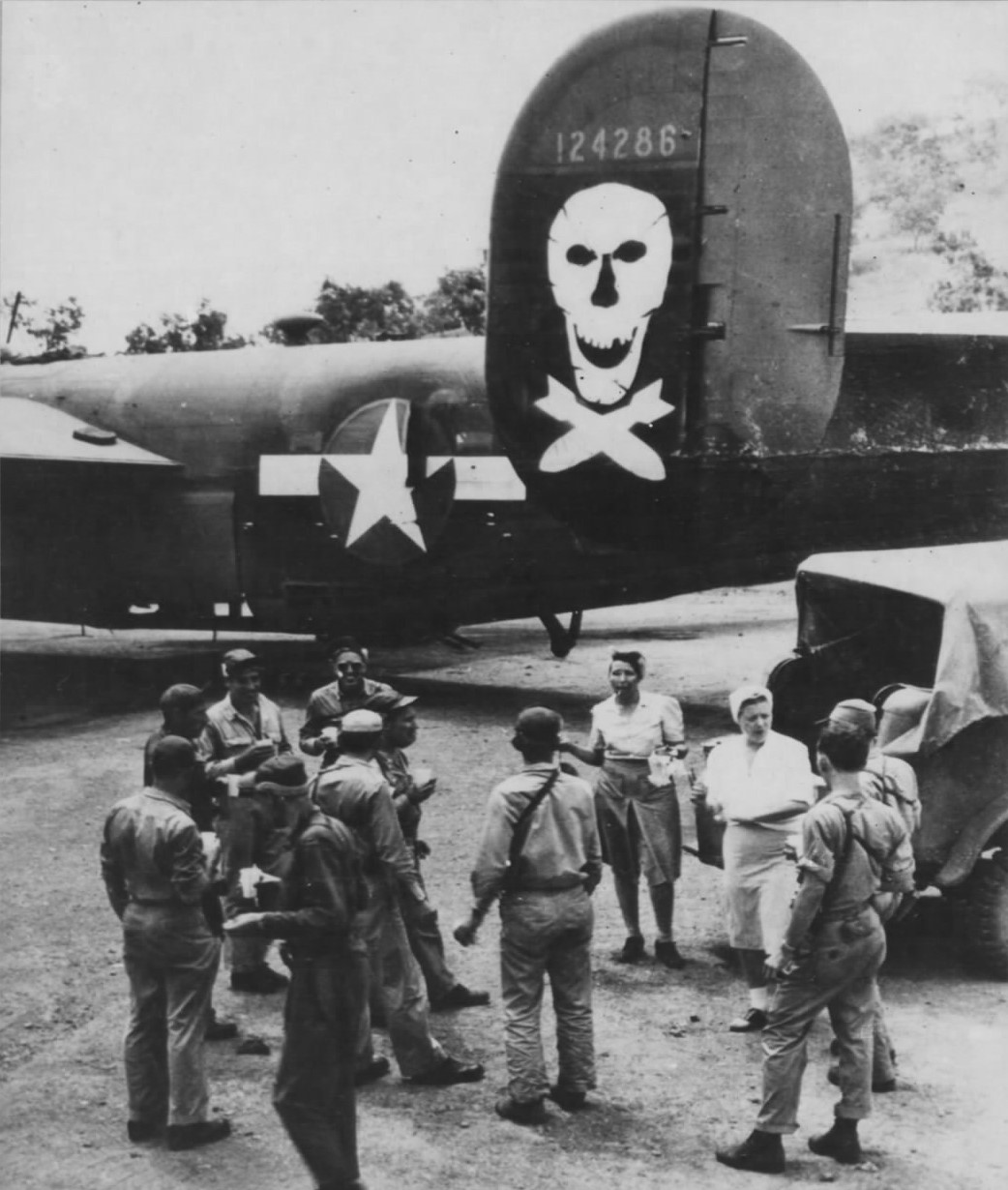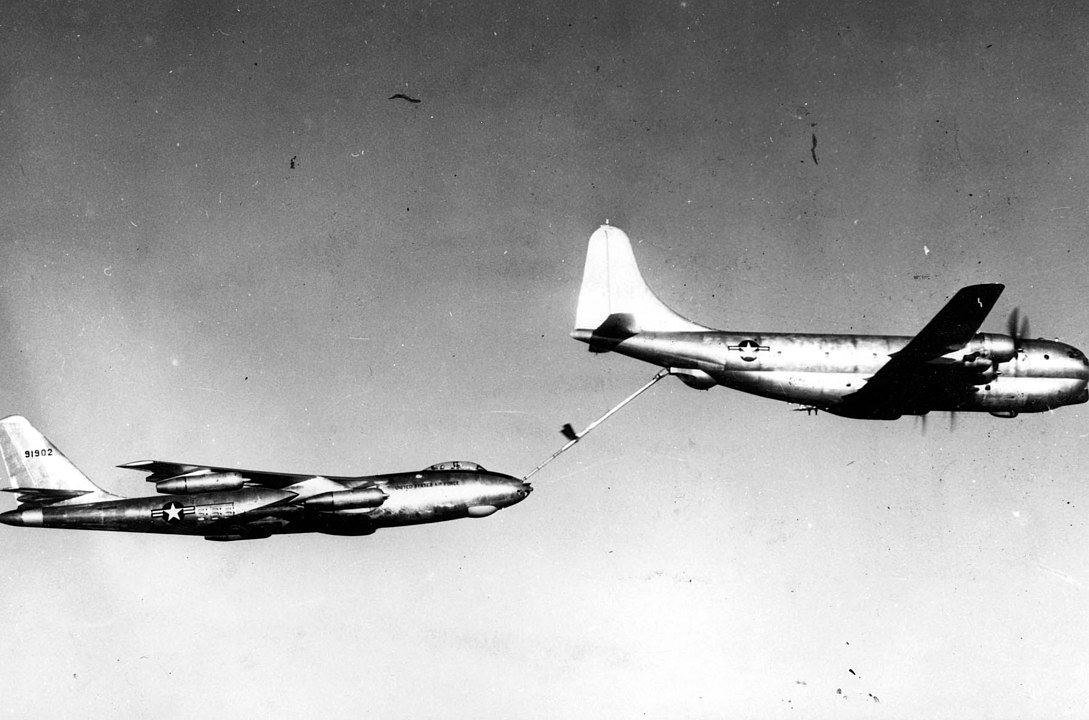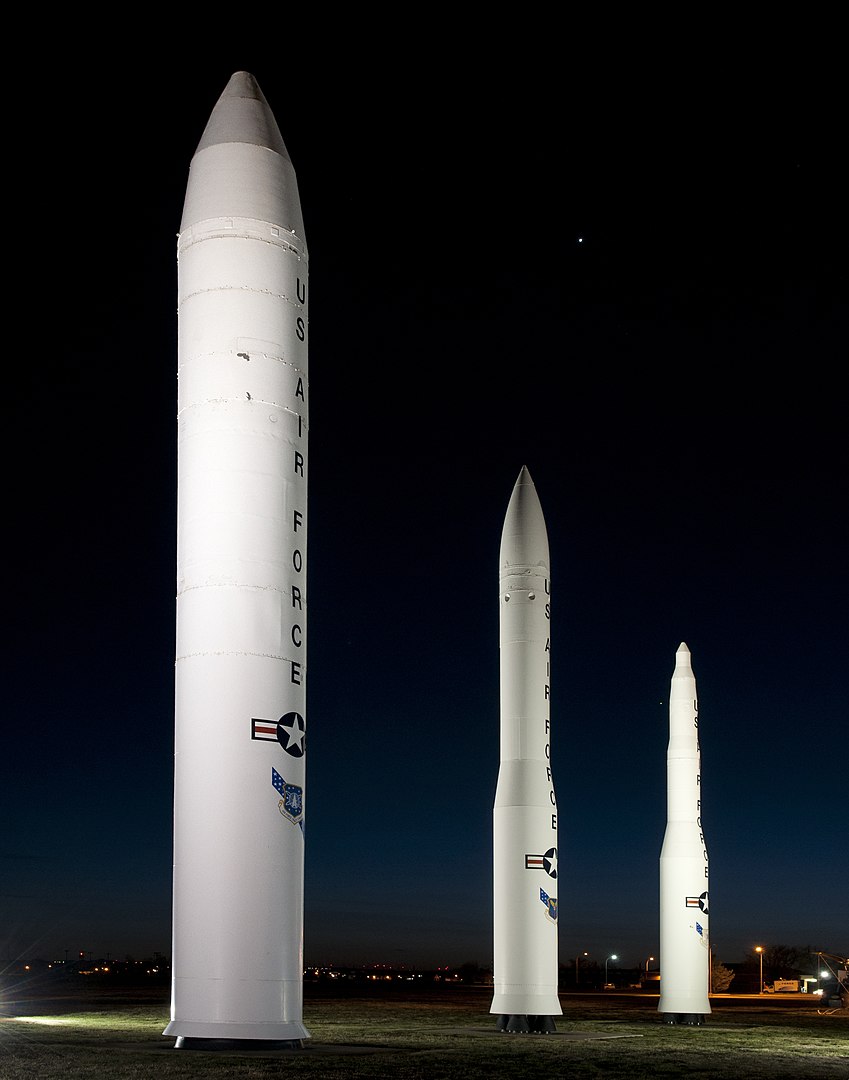The 90th Missile Wing (MW) traces its lineage to the establishment of the 90th Bombardment Group (BG) (Heavy), on 28 January 1942. The 90 BG was a U.S. Army Air Forces, Consolidated B-24 Liberator heavy bomber unit that served in the Pacific Theater of World War II (1939-1945). Subsequent to its establishment the group was activated on 15 April 1942 at Key Field, Meridian, Mississippi, and then—following the end of the war—it was inactivated on 27 January 1946 at Fort William McKinley [Fort Bonifacio], Luzon, Republic of the Philippines. Owing to its WWII heritage, the 90 MW is authorized to display honors earned by the 90 BG during the war. This includes six WWII Campaign Streamers, two Distinguished Unit Citations and a Philippine Presidential Unit Citation.
 Caption: Airmen of the 400th Bombardment Squadron, 90th Bombardment Group, are offered hot food and coffee by Red Cross Workers. Note the 90 BG’s iconic (and unofficial) “Jolly Roger” tail flash, painted on the Consolidated B-24 Liberator in the background. Liberator B-24 D #41-24286 was nicknamed “Gone with the Wind.” Although the photo’s exact date and location are unknown it was most certainly taken in the Pacific Theater between 1943 and 1945. The photo was released to the public by the Air Surgeon’s Office on 5 March 1946. (USAAF Photograph, National Archives and Records Administration Reference Number 342-FH-3A45245-59662AC)
Caption: Airmen of the 400th Bombardment Squadron, 90th Bombardment Group, are offered hot food and coffee by Red Cross Workers. Note the 90 BG’s iconic (and unofficial) “Jolly Roger” tail flash, painted on the Consolidated B-24 Liberator in the background. Liberator B-24 D #41-24286 was nicknamed “Gone with the Wind.” Although the photo’s exact date and location are unknown it was most certainly taken in the Pacific Theater between 1943 and 1945. The photo was released to the public by the Air Surgeon’s Office on 5 March 1946. (USAAF Photograph, National Archives and Records Administration Reference Number 342-FH-3A45245-59662AC)
The 90 MW was established as the 90th Bombardment Wing (BW), Medium, on 20 December 1950 and assigned to Strategic Air Command (SAC). It was activated on 2 January 1951 at Fairchild Air Force Base, Spokane, Washington as a Boeing B-29 Superfortress training wing. On 14 March 1951, the wing was relocated to Forbes AFB, Kansas, and on 16 June 1952 it was redesignated as the 90th Strategic Reconnaissance Wing (SRW). The unit’s B-29s were eventually replaced with the RB-47 Stratojet and in 1953, the wing commenced flying reconnaissance missions out of Eielson AFB, Alaska. In 1955, the 90 SRW added in-air refueling to its mission set and began operating a fleet of Boeing KC-97 Stratofreighters. However, in 1958 SAC returned the wing to a training mission for the RB-47. On 20 June 1960 SAC inactivated the 90 SRW.
 Caption: A 90th Strategic Reconnaissance Wing, Boeing KC-97 Stratofreighter, conducts in-air refueling with one of the wing’s Boeing B-47 Stratojets, circa 1955. (USAF Photograph)
Caption: A 90th Strategic Reconnaissance Wing, Boeing KC-97 Stratofreighter, conducts in-air refueling with one of the wing’s Boeing B-47 Stratojets, circa 1955. (USAF Photograph)
On 21 February 1963 SAC redesignated the 90 SRW as the 90th Strategic Missile Wing (SMW) and later that summer, on 1 July, the unit was reactivated at Francis E. Warren AFB, Wyoming. This included concurrent activations of the 319th, 320th, 321st and 400th Strategic Missile Squadrons (SMS). The following month, on 9 June, the wing received its first LGM-30B Minuteman I, Intercontinental Ballistic Missile (ICBM). On 15 June 1965, the 90 SMW placed its 200th missile on alert and became the first fully operational Minuteman (MM) wing.
In 1972, after operating the MM IB for nearly a decade, the 90 SMW commenced the implementation of SAC’s Force Modernization Program. This initiative sought to replace the MM IB with the more advanced LGM-30G Minuteman III. The following year, the 400 SMS became the first all MM III squadron in the wing and additionally, the 37th Air Rescue and Recovery Squadron (later the 37th Helicopter Squadron) took over the 90 SMW’s helicopter operations. On 3 September 1974, the 90 SMW removed its last MM IB from alert status.
As Cold War (1947-1991) tensions persisted into the 1980s, the LGM-118 Peacekeeper ICBM was added to the U.S. Air Force’s nuclear arsenal. On 10 October 1986, the 90 SMW boasted the first strategically postured Peacekeeper site and by 16 December, the wing reached initial operating capability for the system. On 1 September 1991, the 90 SMW was redesignated as the 90th Missile Wing with a five group organization which included: Operations, Logistics, Security Police, Support and Medical. However, as a result of the post-Cold War reorganization of the Air Force, SAC was deactivated in 1992 and the 90 MW was reassigned to Air Combat Command (ACC). That same year the wing was again redesignated, this time as the 90th Space Wing (SW) and then on 1 July 1993, it was reassigned to Air Force Space Command (AFSPC).

Caption: A static display of ICBMs at Francis E. Warren AFB, WY, taken on 4 April 2012. From left to right are the Peacekeeper, Minuteman III and Minuteman I, ICBMs. (U.S. Air Force photo by R.J. Oriez)
Beginning in 1994, in an effort to extend the service life of the MM III, USAF ICBM units commenced a missile modification program known as the Minuteman Integrated Extension or Rivet MILE. The following year, the 90 SW also initiated the third major life milestone for the MM III, known as the Rapid Execution and Combat Targeting (REACT) modification program. REACT directly improved MM III launch control centers. And, while the MM III’s life was extended, a series of U.S. and Russian Federation nuclear agreements in the early 2000s resulted in a phased deactivation of the Peacekeeper system beginning in 2002. That same year the wing’s groups were reorganized to reflect: operations, maintenance, security forces, mission support and medical.
On Sept. 14, 2005, the 90 SW completed the deactivation of the last of its Peacekeeper ICBMs and then the following month deactivated the 400th Missile Squadron. Three years later, on 1 July 2008, the 90 SW was once again redesignated as the 90th Missile Wing. That same year the wing completed the Guidance Replacement Program which focused on improving MM system guidance operations and maintenance. This was followed in 2009 by the completion of the Propulsion Replacement Program which updated all the wing’s MM III boosters. That same year on 1 December, the 90 MW was reassigned to Air Force Global Strike Command (AFGSC).
In 2014, following a series of operational and training related ICBM incidents at Malmstrom and Minot AFB, AFGSC directed the implementation of a Force Improvement Program that restructured ICBM operations and training in order to improve mission success and missile crew morale.
Continuing to lead the way in ICBM operations, in 2020, AFGSC announced that the 90 MW had been selected to be the first USAF ICBM unit to transition to a more advanced Ground Based Strategic Deterrent (GBSD) missile system—known as the LGM 35A Sentinel.
Since its establishment in 1950, the wing has earned 13 Air Force Outstanding Unit Awards and one service streamer for its contributions to the Global War on Terrorism (GWOT-S).
- Jeremiah D. Foster, Historian
Sources: (U) Adams, Gerald M. The Post Near Cheyenne: A History of Fort D.A. Russell, 1867- 1930. Boulder, CO: Pruett Publishing, 1997; (U) Taylor, Paula Bauman. F.E. Warren Air Force Base. United States: Arcadia Pub., 2012; (U) 90th Missile Wing History Office, “History of the 90th Missile Wing,” F.E. Warren AFB, WY, 2020.
For all official requests for historical information, please submit at Freedom of Information Act request at https://www.foia.gov.
*For F.E. Warren Museum inquiries contact the museum curator at (307) 773-2980.